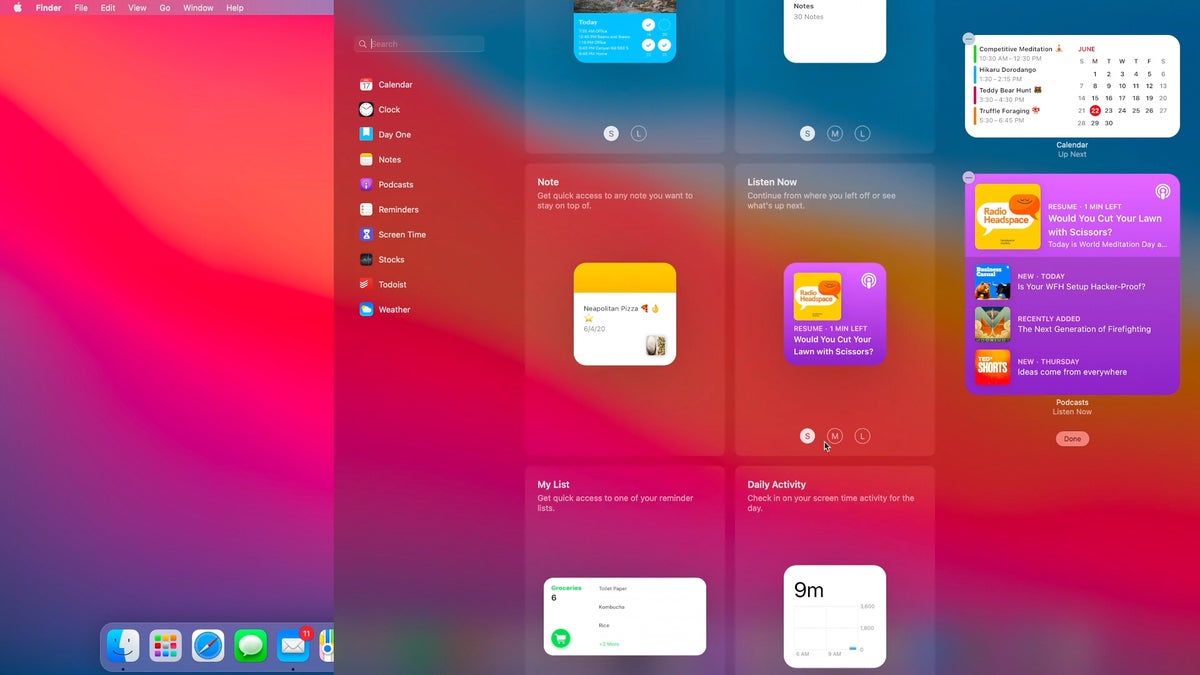- Imac Late 2013 Big Sur
- How To Install Macos Big Sur On Unsupported Mac
- How To Install Macos Big Sur 11.2 On An Unsupported Mac
To install macOS Big Sur on an unsupported Mac we must do it on a disk partition and from macOS Catalina. This way if something goes wrong, we can always continue using our Mac as if nothing else. To make a partition follow these steps: Click on the magnifying glass and look for the app Disk utility. Up click on Create partition. Install Macos 10.15 Catalina On An Unsupported Mac MacOS Big Sur 11.0 and later allows management of legacy system extensions for both Intel-based Mac computers and Mac computers with Apple silicon. How to manage legacy system extensions Kernel extensions that use previously deprecated and unsupported KPIs no longer load by default. Install macOS Big Sur Beta.dmg.7z.001 Only this file Install macOS Big Sur Beta.dmg. Wait until the end - after you get 1 file So now you cal easily delete all 7 parts Then open disk utility - choose Flash Drive - Completely format it Name it Install macOS Big Sur Beta- Format MacOS Extended (NOT APFS) - scheme GUID. After erasing click.
- The official version of macOS Big Sur is released
macOS Big Sur brings the combination of powerful strength and beautiful appearance to a new level. The carefully crafted new design allows you to fully experience the charm of the Mac; the Safari browser is ushered in a major update, waiting for you to enjoy; the map app and the information app are loaded with new functions for you to explore; more transparent privacy permissions, protection More thoughtful.
macOS Big Sur 11 release date: 2020.11.12 - Unsupported models and problems
According to the summary of macrumors, unsupported Macs can be divided into several situations:
Mac models that officially support macOS Catalina but are not supported by macOS Big Sur:
– These Macs can run Big Sur normally, but Wi-Fi cannot work normally. (This type of model is the easiest to run Big Sur perfectly through the patch, currently it is only a Wi-Fi problem.)
You can follow the steps below, this article is mainly for this type of model.
2012 and Early 2013 MacBook Pro
Not officially supported in macOS Catalina, but are fully capable of running both Catalina and large Sur with a Metal-compatible GPU and upgraded Wifi/BT card. Mac can be patched to run macOS Catalina normally, and it may be patched to run macOS Big Sur: – These Macs can currently launch Big Sur, but there is currently no Wifi or graphics acceleration support. This type of model requires additional steps to solve installation problems. Early-2008 or newer Mac Pro, iMac, or MacBook Pro: MacPro3,1
Macmini5,x (systems with AMD Radeon HD 6xxx series GPUs were almost unusable when running Catalina and will be under Big Sur as well.)
MacBook5,2
Xserve3,1*
*Not officially supported in macOS Catalina, but are fully capable of running both Catalina and large Sur with a Metal-compatible GPU and upgraded Wifi/BT card.
Completely unsupported Mac:
This type of model does not need to consider installing Big Sur.
Macmini2,1
— The 2007 iMac 7,1 is compatible with Catalina and potentially Big Sur if the CPU is upgraded to a Penryn-based Core 2 Duo, like a T9300.
2006-2008 MacBooks:
MacBook4,1 (as with Mojave and Catalina, we’ll get on our own here, but Big Sur are going to be running on this machine!)
2008 MacBook Air (MacBookAir 1,1)
All PowerPC-based Macs
All 68k-based Macs - Download macOS Big Sur
Mac App Store
Open the App Store and directly search for macOS to download.
After the download is complete, you can see that Install macOS Big Sur is located in the application (Application) directory.
Baidu SkyDrive DMG Mirror
Please visit: https://sysin.org/article/macOS-Big-Sur/
After downloading, double-click to open the dmg file, and drag Install macOS Big Sur to the application (Application). - Patch Tool Download
(1) Hax.dylib: link 1
(2) big-sur-micropatcher - Installation method: new installation or upgrade installation under the current system
(0) Prerequisites
Make sure the Mac is currently running on macOS Catalina.
(1) Boot to recovery mode (recovery mode)
When booting or restarting, press and hold Command + R until the splash screen (Apple logo) appears.
If there is no recovery partition, you need to press Command + Option + R to start Internet Recovery.
(2) Disable sip (System Integrity Protection)
Utilities -> Terminal Enter the command csrutil disable and press enter.
(3) Disable compatibility check
Continue to execute commands in the terminal:
1
nvram boot-args=”-no_compat_check”
(4) Restart, start macOS Catalina normally
(5) Disable libraries validation
Open the terminal and execute the command:
1
sudo defaults write /Library/Preferences/com.apple.security.libraryvalidation.plist DisableLibraryValidation -bool true
(6) Insert library
Put the downloaded Hax.dylib file in the home directory, namely /Users// directory, and execute the command in the terminal:
1
launchctl setenv DYLD_INSERT_LIBRARIES $PWD/Hax.dylib
(7) Start to install macOS Big Sur
Clean install
Before starting the installation, we open the “Disk Utility” to create a new APFS volume, and then double-click Install macOS Big Sur in the application to start the installation. Select the newly created volume as the target disk. After the installation is complete, it will automatically boot to the new system.
After installation, you can delete the APFS volume where the original system is located, leaving only the Big Sur system.
Upgrade installation
Double-click Install macOS Big Sur in the application to start the normal installation. The installation target partition selects the partition where the current system is located, that is, the upgrade installation is performed automatically.
By default, the factory setting has only one partition named: Macintosh HD
(8) Solve the problem of network card driver
In some models, the wireless network card is already working (Late 2013 iMac, or your 2012/2013 model uses an 802.11ac network card instead of an 802.11n network card).
If the wireless network card cannot work, you need to deal with it as follows:
You need to use the method in item 7 below to create a bootable U disk. Restart the system, hold down the Option key until the boot partition selection screen appears, boot to “Install macOS Big Sur”, after booting, select “Utilities -> Terminal” and execute the following commands (three formats) Both can be supported, choose one of them, “Macintosh HD” is your default system installation partition name, replace it according to the actual name):
1
2
3
/Volumes/Image Volume/patch-kexts.sh /Volumes/Macintosh HD
‘/Volumes/Image Volume/patch-kexts.sh”/Volumes/Macintosh HD’
“/Volumes/Image Volume/patch-kexts.sh” “/Volumes/Macintosh HD”
Then restart to macOS Big Sur, at this time Wi-Fi is already normal. - Installation method: fresh installation using removable media
Tip: U disk can also be replaced by mobile hard disk, especially SSD mobile hard disk, which is faster.
7.1, create boot media
(1) Create a bootable U disk
Prepare a 16G or above U disk, open “Utilities> Disk Utility”, select the U disk, click “Erase”, the format is as follows:
Mac OS X extension (Journaled);
GUID partition map;
Partition name: MyVolume (The default is Untitled, which can be customized. Note that MyVolume in the terminal command below should also be changed to the same name you customized)
Open the terminal and execute the following command:
1
sudo /Appli
- (The Host Mac will do the work and the Target Mac is the Mac you need to Restore) 1. USB-C Mac as the Host Machine. The Host Mac must have at least macOS 10.15.6 and Apple Configurator 2.13.1 or newer installed. (Version 2.13.2 is the latest as of 11/18/20) 3.
- How To Install MacOS Catalina On Unsupported Mac How To Download Macos Catalina Dmg File Ver-10.15.4 (Direct Links) How To Download Macos Catalina Iso For Vmware & Virtualbox: Direct Links How To Download Macos 10.15 Catalina Iso + Dmg + Vmdk How To Install MacOS Catalina On VirtualBox On Windows: 8 Step Ultimate Guide.

This article is intended for system administrators at businesses and educational organizations.
About system extensions in macOS
Install Macos 10.15 Catalina On An Unsupported Mac

Imac Late 2013 Big Sur

MacOS Big Sur 11.0 and later allows management of legacy system extensions for both Intel-based Mac computers and Mac computers with Apple silicon. How to manage legacy system extensions Kernel extensions that use previously deprecated and unsupported KPIs no longer load by default.
System extensions on macOS Catalina 10.15 and later allow software, such as network extensions and endpoint security solutions, to extend the functionality of macOS without requiring kernel-level access. Learn how to install and manage system extensions in user space instead of the kernel.
Legacy system extensions, also known as kernel extensions or kexts, execute in a highly privileged mode of the system. Starting with macOS High Sierra 10.13, a kernel extension must be approved by an administrator account or a Mobile Device Management (MDM) profile before it can load.
macOS Big Sur 11.0 and later allows management of legacy system extensions for both Intel-based Mac computers and Mac computers with Apple silicon.
How to manage legacy system extensions
How To Install Macos Big Sur On Unsupported Mac
Kernel extensions that use previously deprecated and unsupported KPIs no longer load by default. You can use MDM to modify default policies to not show dialogs periodically and to allow the kernel extensions to load. For Mac computers with Apple silicon, you must first change the security policy.
Install nextcloud on docker. To install a new or updated kernel extension in macOS Big Sur, you can do either one of the following:
- Instruct the user to follow the prompts within Security & Privacy preferences to allow the extension, then restart their Mac. You can permit users who are not administrators to allow the extension using the
AllowNonAdminUserApprovalskey in the Kernel Extension Policy MDM payload. - Send the
RestartDeviceMDM command and set theRebuildKernelCachekeyto True.
How To Install Catalina Unsupported Mac
Any time the set of approved kernel extensions changes, either after initial approval or if the version is updated, a restart is required.
How To Install Macos Big Sur 11.2 On An Unsupported Mac
Additional requirements for Mac computers with Apple silicon
Mac computers with Apple silicon require kernel extensions to be compiled with an arm64e slice.
Before you can install a kernel extension on a Mac computer with Apple silicon, the security policy must be changed in one of the following ways:
- If you have devices enrolled in MDM with Automated Device Enrollment, you can automatically authorize remote management of kernel extensions and change the security policy.
- If you have devices enrolled into MDM with Device Enrollment, a local administrator can change the security policy manually in macOS Recovery and authorize remote management of kernel extensions and software updates. Additionally, an MDM administrator can advise the local administrator to make this change by setting
PromptUserToAllowBootstrapTokenForAuthenticationin MDMOptions or by setting the same key in the MDM profile. - If you have non-MDM devices or devices enrolled into MDM with User Enrollment, a local administrator can change the security policy manually in macOS Recovery and authorize user management of kernel extensions and software updates.